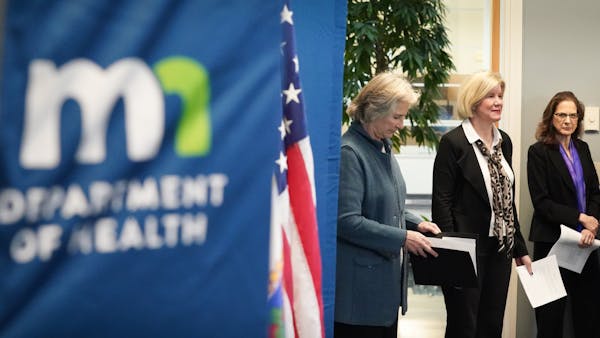Minnesota might need 4,000 more workers to identify and isolate the surging number of COVID-19 infections and their contacts, a state official said Wednesday.
Known as contact tracers, they are a vital part of the "test, trace and isolate" strategy that the state has embraced to control the spread of the new coronavirus, which has sickened 8,579 and led to 485 fatalities.
"We are going to need to dramatically build up our capacity," Deputy Health Commissioner Margaret Kelly said. "We could need as many as 4,200 tracers."
An increase in COVID-19 testing, especially in response to outbreaks in food processing plants and long-term care facilities, has meant that the number of confirmed cases has jumped 85% in the past week.
With a complement of 150 workers to interview the new cases and also to call their contacts, who might be at risk of becoming ill, the state could be in danger of falling behind on preventing new illnesses.
"It is taking us longer to do that initial outreach to individuals," Kelly said. "We want to ensure that we are acting as quickly as possible to have them isolate themselves."
As it stands, nearly four out of every 10 confirmed cases lack key epidemiological information on the likely route of COVID-19 exposure, according to Minnesota Department of Health data released Wednesday.
That's up from two weeks ago, when just 17% of cases had unknown or missing information on exposure.
About 18% of cases were linked to congregate care residents or staff, 5% were related to travel to hot spots, 28% were community transmission and 5% were in health care workers.
A few weeks ago, the plan was to have 750 people perform contact investigations and tracing, mostly by redeploying Health Department and other state workers because of a hiring freeze.
This week, 160 new workers were slated to come online, but the increasing caseloads have led to a re-evaluation of need.
"Our estimates of that have really changed and been informed by all that we have learned in the last six weeks or so," Health Commissioner Jan Malcolm said.
The timeliness of investigations is important because one of the goals is to talk with close contacts, usually family members, friends or co-workers, and ask them to isolate at home for up to two weeks so they won't infect others.
That's especially important given that researchers have found that infected people without symptoms are playing a key role in the growth of the pandemic.
The state might farm out some of the work to local public health agencies, which traditionally have played a role in disease outbreaks such as measles, mumps and tuberculosis.
Malcolm said the Health Department is looking at how other states are carrying out this work, including recruiting qualified volunteers.
The state might also use public health students from the University of Minnesota, Kelly said.
A Minnesota House health committee is considering a bill to provide funding for contact tracers, perhaps with some federal help.
Two counties outside the metro area recently saw significant increases in cases due to outbreaks at food processing plants. Nobles County now has 1,082 cases and there are 975 cases in Stearns County.
Wednesday's release of COVID-19 data included 728 new cases, setting a new one-day record, as well as 30 deaths, another daily record.
Twenty-four of the deaths were among long-term care residents. So far, 80% of all deaths have been among residents of nursing homes and assisted-living facilities. More than nine in 10 COVID-19 deaths have involved residents of these facilities, or people with underlying health conditions such as diabetes, compromised immune systems, and diseases of the heart, kidney or lungs.
There were 433 people hospitalized due to COVID-19 infection, including 180 needing intensive care. Although ICU bed use is gradually increasing, the number of patients who don't require a ventilator but need to be hospitalized is going up at a faster rate.
The Health Department, along with the University of Minnesota School of Public Health, has completed the third version of a public health model that will attempt to estimate hospital usage, deaths and caseloads under various scenarios.
The model is being reviewed by outside experts before it will be released to the public, and Malcolm said she might not see it until Friday.
Meanwhile, state budget forecasters said Tuesday that the pandemic is expected to increase enrollment in the state's Medicaid and MinnesotaCare programs.
With more than 620,000 claims for unemployment insurance filed by Minnesota workers, an increase in government-funded health insurance was expected.
During economic downturns, enrollments in programs like Medicaid tend to come later after conditions worsen, the state budget forecasters noted. They are projecting a 2% increase in Medicaid for the state fiscal year that ends in June.
Next year, the Medicaid rolls could increase 10% above what was expected in the February forecast. That would put the program at nearly 1.2 million Minnesotans.
MinnesotaCare, a separate program for people who make slightly more than Medicaid income limits, would see 30% growth in 2021 to slightly more than 100,000 enrollees.
Even with the enrollment increases, the state's health budget forecast would fall by $160 million, thanks to enhanced federal Medicaid payments passed as part of COVID-19 relief packages.
Meanwhile, a coalition of businesses representing restaurants, hotels, bars, resorts and craft brewers called for more federal and state aid to stem the tide of business closures.
They are asking the state for an additional $120 million for the small-business emergency loan program, as well as waiving sales taxes, delaying property taxes, suspending regulatory fees and temporarily ending evictions by commercial landlords.
"Hospitality businesses and jobs are teetering on an economic cliff," said Liz Rammer, chief executive of Hospitality Minnesota. "This will help turn the state's budget and economy around more quickly by generating revenue."
8 months in jail for Blaine man who caused 120-mph crash hours after he was caught speeding

Daughter sues St. Paul, two officers in Yia Xiong's killing

